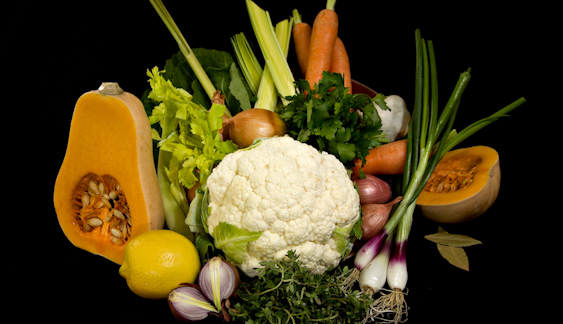Ultimate Vegetable Stock

introduction
We hate to begin a recipe for vegetable broth with a glowing disquisition on meat, so we won’t, but one thing is certain: cooking vegetables can be much tougher than cooking meat. Throw a chop in a skillet and get the prelude to a pan sauce with bronzed drippings and juices. Simmer fleshy bones in water and be rewarded, for only modest effort, with a couple of quarts of liquid gold in the form of stock, the foundation of flavor depth and body in virtually every dish.
Draw vegetables into a meal’s leading role, however, and you often discover a labor to return ratio that is the inverse of meat’s. It’s also six hours later. But should you wish, for reasons of personal ethics, health, or preference, to create vegetarian dishes, dishes of light, singing delicacy, dishes that rise to the task of flavor layering, a fine homemade vegetable broth is the first and most crucial step.
Don’t think you can buy your way out of this one: canned or boxed vegetable broth is even more vile and bogus than the commercial version of chicken broth—if that is possible. And though it may seem crazy to relegate so many fine, upstanding vegetables to the compost pile, it won’t seem crazy when you taste a simple plate of broccoli florets, flash-simmered and infused with this broth, then finished with olive oil, lemon, and garlic. Or when your next vegetable soup looks not in vain to water for flavor. Or when you taste our Carolina Gold Rice Grits Cakes.
Cooking Remarks
Without proper supervision, vegetable broth can easily drift into the dangerous waters of sweet vegetable tea. This happens when too many members of the onion family get together for a reunion and invite only their immediate relatives. Any broth or stock needs a fair representation of aromatics, but without the infusion of meat, a vegetable broth requires careful attention to balance. Here, we bring balance in the form of collard greens (bracing but not sulfurous) and cauliflower (soulful and delicate, not pushy like your average crucifer). Slices of winter squash, seeds and all, impart both depth and dimension to this broth. The splendid reedy tang of bruised lemongrass catches the attention of all the other vegetables. Okay, now, everyone in the pool!
If it is not the season of winter squash, feel free to omit it. The squash isn’t a make-or-break proposition for this recipe, but its glycerin contribution offers a silky weight and density to the body of the broth as well as a softly, sweet floral counterpoint to the other vegetables. This broth freezes well.
equipment mise en place
For this recipe, you will need a heavy-bottomed 8-quart stockpot with a lid, a wooden spoon, a large fine-mesh strainer, and a large heatproof bowl.
-
-
2medium yellow onions, peeled and chopped
-
3large shallots, peeled and sliced
-
2large or 4 small leeks, white and light green parts only, halved lengthwise, washed well, and sliced
-
1garlic head, unpeeled and halved
-
2small celery ribs, chopped
-
2small carrots, peeled and chopped
-
Vegetable oil spray
-
3quarts spring or filtered water
-
1small cauliflower head (12 ounces), trimmed of stem and leaves, sliced
-
½small acorn squash or the bulb end of a butternut squash, unpeeled and with seeds, cut crosswise into 5 slices, each about ½ inch thick
-
3large fresh thyme sprigs
-
1Turkish bay leaf
-
2teaspoons fine sea salt
-
2teaspoons black peppercorns
-
1bunch collard greens (12 ounces), washed and chopped
-
1bunch flat-leaf parsley, washed, shaken dry, and coarsely chopped
-
2scallions, trimmed
-
1stalk lemongrass, trimmed to the bottom 6 inches and bruised with the back of a chef’s knife, or 1 lemon, halved
-
-
Toss the onions, shallots, leeks, garlic, celery, and carrots in a heavy-bottomed 8-quart stockpot. Spray the vegetables with vegetable oil spray for 10 seconds, and then stir well to coat. Cover the pot and cook the vegetables over low heat, stirring occasionally, until they are softened, fragrant, and beginning to color, about 30 minutes. (If, after 30 minutes, the vegetables haven’t begun to color, uncover the pot and cook 15 minutes more.)
-
Increase the heat to medium-high and add the water, cauliflower, squash, bay leaf, salt, and peppercorns. Bring to a boil, reduce the heat to low and simmer, uncovered, until the vegetables are spent, about 30 minutes, adjusting the heat as needed to maintain a gentle but active simmer. Add the collard greens and parsley, pushing them into the liquid, and simmer for 10 minutes. Chop the scallions and add them to the pot along with the lemongrass or halved lemon. Remove the pot from the heat and let the stock steep for 5 minutes. Strain the stock through a large fine-mesh strainer into a large heatproof bowl.
A version of this recipe by the same author, Kay Rentschler, originally appeared in Cook’s Illustrated magazine.